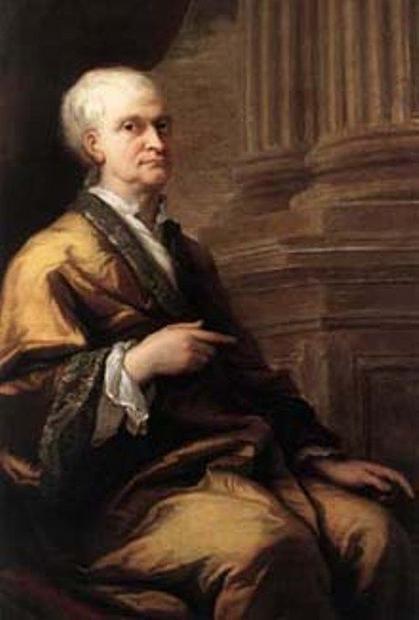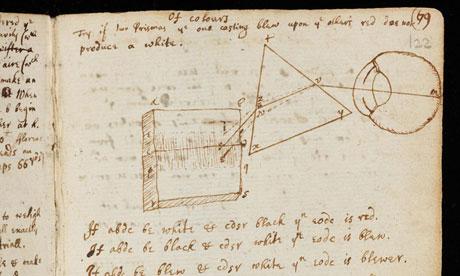|
دانشگاه کمبريج برای اولين بار نوشته های اسحاق نيوتن از جمله نسخه
ای از کتاب "اصول
رياضيات" که
حاوی حاشيه نويسی و محاسبات اين رياضی دان مشهور روی برگه های اين
کتاب است را روی شبکه اينترنت منتشر خواهد کرد.

چهره اسحاق نيوتن در سن ۴۶ سالگی.
به نوشته روزنامه "گاردين"،
تاکنون حدود چهار هزار صفحه که تقريبا ۲۰ درصد از بايگانی اين
دانشگاه از آثار نيوتن را شامل می شود، به صورت نسخه ديجيتال تهيه
شده و در آينده نزديک به عنوان بخشی از طرح "ارائه
آثار دانشمندان بزرگ به عموم" همراه
آثاری از داروين و سايرين روی شبکه اينترنت قرار خواهند گرفت.
بخشی از مجموعه مربوط به اسحاق نيوتن، يادداشت های همکار او "توماس
پلت" است
که به درخواست خانواده نيوتن و پس از مرگ وی در سال ۱۷۲۶ نوشته شده
است. آنها از "توماس
پلت" خواسته
بودند تا آثار نيوتن را برای چاپ مورد بازبينی قرار دهد.
در اين مجموعه می توان حاشيه نويسی های "توماس
پلت" روی
آثار نيوتن را ديد که در برخی موارد تذکر داده است که قسمت هايی از
کتاب نيوتن قابليت چاپ ندارد. مسلما چنين بخش هايی از بايگانی
دانشگاه کمبريج بيش از همه توجه علاقمندان به علوم و دانشمندان را
به خود جلب خواهد کرد.
اين طور گفته می شود که "توماس
پلت" در
اين بازبينی سعی کرده که برخی از محاسبات و معادلات رياضی اسحاق
نيوتن که در دوران جوانی نوشته شده بود را حذف کرده و مهمتر از آن
ديدگاه های غير مذهبی خود را در متن اين نوشته ها دخالت دهد.
به نوشته روزنامه گاردين، بخش ديگری از آثار اسحاق نيوتن که توسط
دانشگاه کمبريج روی شبکه اينترنت قرار خواهند گرفت دفترچه های
يادداشت اين رياضی دان است که حاوی تمام پژوهش های وی در سال ۱۶۶۵
ميلادی است؛ یعنی سالی که دانشگاه کمبريج به خاطر شيوع طاعون در
انگلستان تعطيل شده بود.
منبع: گاردین
London -
Cambridge University has made available online original
manuscript of Sir Isaac Newton's famous laws of motion. Also
online are other famous works of Newton, including a personal
annotated copy of Philosophiae Naturalis Principia Mathematica.
UK Press Association reports
the manuscripts include 4,000 pages of the scientists works on a
new digital library website. The digital library plans to make
the entire collection of Newton's work available for anyone to
view and download at Cambridge
Digital Library.
The work to
make Newton's manuscripts available online began in
2010. The original manuscripts were photographed
with about 200 pages being captured each day.
Precaution to conserve several of the manuscripts
that had deteriorated from age were taken before
they were photographed.
Daily Mail reports
that Grant Young, digitization manager at the Cambridge
University Library, said: "We are launching our collections to
the world with perhaps some of the most important papers and
documents in the history of science. In addition to his
Principia and notebooks, we've included his 'Waste Book' - a
very large notebook Newton inherited from his stepfather and
filled with notes and calculations when he was forced to leave
his studies in Cambridge during the Great Plague. With plenty of
time and paper to hand, Newton was able to make significant
breakthroughs, particularly in his understanding of calculus.
Anyone, wherever they are, can see at the click of a mouse how
Newton worked and how he went about developing his theories and
experiments. Newton's copy of his Principia shows how
methodically he worked through his text; marking alterations,
crossing out and annotating his work in preparation for the
second edition. Before today, anyone who wanted to see these
things had to come to Cambridge. Now we're bringing Cambridge
University Library to the world."

James Thornhill (1675�1734)
Isaac Newton in old age in
1712, portrait by Sir James Thornhill
The Guardian reports
that papers published online include handwritten
notes made after Newton's death in 1727 by his
colleague Thomas Pellet. Pellet's censoring comment
"Not fit to be printed," appeared on several pages
of the original manuscript. Pellet, according to The
Guardian,
was trying to prevent publication of his unorthodox
religious views and some of his calculations which
he considered immature.
The Guardian quotes
Grant Young, saying: "You can see Newton's mind at
work in the calculations and how his thinking was
developing. His copy of the Principia contains pages
interleaved with the printed text with his notes.
The book has suffered much, pages are badly burned
or water-stained, so it is very delicate and rarely
put on show."
The university librarian Anne Jarvis, explained
that: "Over the course of six centuries Cambridge
University Library's collections have grown from a
few dozen volumes into one of the world's great
libraries, with an extraordinary accumulation of
books, maps, manuscripts and journals. These cover
every conceivable aspect of human endeavor, spanning
most of the world's cultural traditions."
The digital library also plans to upload collections
of original manuscripts by other famous British
scientists such as Charles Darwin and Ernest
Rutherford. Other papers to be uploaded include the
18th-century Board of Longitude, which was charged
with securing a more accurate method of sea
navigation. Records of early astronomers, including
Edmund Halley and John Flamsteed, will also be made
available online.
Philosophiae
Naturalis Principia was
first published in July 1687. The book describing
Newton's laws of motion and his law of universal
gravitation is regarded by scientists as one of the
most important theoretical discoveries in the entire
history of science.
Daily Mail reports
Polonsky Foundation, an organization that supports
education and arts, provided a gift of 1.5 million
pounds for the project.
Source: The
Gardian
Sir Isaac Newton's own
annotated Principia Mathematica goes online
Cambridge University gives the public access to digitised
science papers, revealing the calculations of famous minds

Original
manuscript by Sir Isaac Newton, one of several by the
English physicist to be made available on the web.
Photograph: Cambridge University Library/PA
Cambridge
University is putting the papers of Sir Isaac
Newton online
for the first time, including his own annotated copy of his
greatest work, Principia Mathematica, with notes and
calculations in his handwriting revising the book and
answering critics.
So far,
more than 4,000 pages, about 20% of
the university's Newton archive,
have been put into digital form as
part of a programme that will
eventually give
the public access to the papers of
other famous scientists,
ranging from Darwin to Ernest
Rutherford. Included in the papers
are the handwritten notes made after
Newton's death, in 1727, by his
colleague Thomas Pellet, who was
asked by relatives of the great
scientist to examine the papers with
a view to publication.
Pellet's dismissive note, saying
"Not fit to be printed", can be seen
on some pages � which are now,
inevitably, among those most closely
studied. It is thought Pellet was
attempting to censor some of
Newton's more juvenile calculations
and, more urgently, stifle his
unorthodox religious views.
Grant Young, the university
library's digitisation manager,
said: "You can see Newton's mind at
work in the calculations and how his
thinking was developing. His copy of
the Principia contains pages
interleaved with the printed text
with his notes.
"The book has suffered much, pages
are badly burned or water-stained,
so it is very delicate and rarely
put on show. Before today anyone who
wanted to see these things had to
come to Cambridge and get permission
to see them, but we are now bringing
Cambridge University library to the
world at the click of a mouse."
Other papers now released come from
Newton's notebooks and the "waste
book" he carried with him to
continue his work while the
university was closed down during
the Plague in 1665.
These documents show his initial
work in understanding calculus.
Among the next papers to be released
will be those of the 18th-century
Board of Longitude, which was
charged with securing a more
accurate method of navigation at
sea.
The records of the early astronomers
royal, including Edmund Halley and
John Flamsteed, will also be put
online. Charles Darwin's papers are
already being published separately
online but eventually will be
incorporated into the digital
project.
1 2 3 4 5 6 7 8 9 10 11 12 13 14 15 16 17 18 19 20 21 22 23 24 25
26 27 28 29 30 31 32 33 34 35 36 37 38 39 40
آخرین
مقالات |




